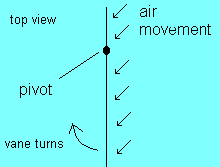
| MadSci Network: Engineering |
Valerie,
An interesting question because most of the web sites I could find don't actually address the underlying principle. By the way, I hope you don't mind a chemist answering your question.
| Without going into complicated integral calculus, a weather vane works, that is points to the direction that the wind is coming from, because the tail is bigger than the head (usually, though not essential... read on). I've shown a rooster, one of the oldest types and hence the term "weathercock". It needn't be. See this interesting link for other styles and the names of all the parts! |  |
| A weather vane is nothing more than a vertical plate (or plates) mounted on a vertical pivot or axle. Now think of the wind as pressure (because it is moving). Pressure is force per area and so force = pressure x area. Therefore the force is greater on the tail than on the head. The tail gets pushed "away" from the direction the wind is coming from, turning the head into the wind. |  |
| Just to complicate things a little, remember your classes on levers and moments? If you haven't got that far, ask your teacher. The moment of a force depends on the distance from the pivot. So a small force at a long distance can overcome a larger force at a short distance. Now, the tail of a weather vane could therefore actually have a smaller area than the head but still turn the vane if it is placed sufficiently far from the pivot! |  |
If you want to make more of your own weather vanes, try one of the
following sites:
What other types of wind-direction indicators have you seen? Maybe a wind-sock at an airport? What about the flag atop the mast of a ship? Automatic steering rudders on sailing yachts work in a similar way as do wind-powered water pumps. You might also want to consider how windmills were made to point into the wind automatically (hint: what does a helicopter have on its tail?). Good luck and thanks for your question.
A Mad & Windy Chemist
Try the links in the MadSci Library for more information on Engineering.